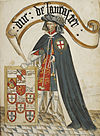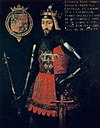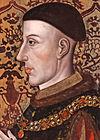Duke of Lancaster
| Dukedom of Lancaster Extinct, merged with Crown | |
|---|---|
  Arms of Henry of Grosmont: the arms of his grandfather Edmund Crouchback (arms of King Henry III, a label France of three points) | |
| Creation date | 1351 (first creation) 1362 (second creation) 1399 (third creation) |
| Monarch | Edward III (first creation) Edward III (second creation) Henry IV (third creation) |
| Peerage | Peerage of England |
| First holder | Henry of Grosmont |
| Last holder | Henry V (merged with crown) |
| Subsidiary titles | First creation Earl of Derby Earl of Leicester Earl of Lancaster Earl of Lincoln Earl of Moray Second creation Earl of Richmond Earl of Leicester Earl of Lancaster Earl of Derby Third creation Earl of Chester (subsidiary of Prince of Wales) |
| Extinction date | 1361 (first creation) 1399 (second creation) 1413 (third creation) |
| Former seat(s) | Lancaster Castle |
The Dukedom of Lancaster is an extinct English peerage. It was created three times during the Middle Ages but finally merged in the Crown when Henry V succeeded to the throne in 1413. Despite the extinction of the dukedom the title has continued to be used to refer to the reigning monarch of the United Kingdom in relation to Lancashire and the Duchy of Lancaster, an estate held separately from the Crown Estate for the benefit of the sovereign.[1]
History[]
There were three creations of the Dukedom of Lancaster during the fourteenth and fifteenth centuries. The first creation was on 6 March 1351 for Henry of Grosmont, 4th Earl of Lancaster, a great-grandson of Henry III; he was also 4th Earl of Leicester, 1st Earl of Derby, 1st Earl of Lincoln and Lord of Bowland. When he died in 1361 the peerage became extinct.
The second creation was on 13 November 1362, for John of Gaunt, 1st Earl of Richmond and third surviving son of King Edward III.[2] He became Henry of Grosmont's son-in-law through his marriage to Blanche of Lancaster, Henry's second daughter and eventual heir. When Gaunt died on 4 February 1399 the dukedom passed to his son, Henry of Bolingbroke, 1st Duke of Hereford. Later that same year Bolingbroke usurped the throne of England from Richard II, becoming Henry IV, at which point the Dukedom merged in the Crown.
Henry re-created the dukedom on 10 November 1399 for his eldest son Henry of Monmouth, Prince of Wales. In 1413 Monmouth ascended the throne as King Henry V and the dukedom merged in the crown again, where it has remained ever since.
Nevertheless, the title continues to be used to refer to the monarch in relation to Lancashire and the Duchy of Lancaster, the estate associated with the former dukedom. It is customary at formal dinners in the historic county boundaries of Lancashire and in Lancastrian regiments of the armed forces for the Loyal Toast to be announced as "The Queen, Duke of Lancaster." In addition, in Lancaster it was quite common as late as the second half of the twentieth century to hear the national anthem sung as "God save our gracious Queen, long live our noble Duke."[3][4] However, the legal basis for the sovereign to use the title has been disputed as the right to the title may have had different heirs to the right to the duchy’s lands. In particular, George V was given legal advice that it was “extremely unlikely” that he was the Duke of Lancaster.[5]
First creation, 1351-1361[]
| Duke | Portrait | Birth | Marriage(s) | Death |
|---|---|---|---|---|
| Henry of Grosmont House of Plantagenet also Earl of Derby (1337), Earl of Leicester (1345), Earl of Lancaster (1345), Earl of Lincoln (1349), Earl of Moray (1359), (1345) |
 |
c. 1310 Grosmont Castle son of Henry, 3rd Earl of Lancaster and Maud Chaworth |
Isabel of Beaumont c. 1337 2 children |
23 March 1361 Leicester Castle aged 50–51 |
| Henry of Grosmont died in 1361 without male issue. | ||||
Second creation, 1362-1399[]
| Duke | Portrait | Birth | Marriage(s) | Death |
|---|---|---|---|---|
| John of Gaunt House of Lancaster (founder) also Duke of Aquitaine (1390), Earl of Richmond (1342–1372), Earl of Leicester, Earl of Lancaster, Earl of Derby, Baron of Halton (1361) |

|
6 March 1340 Ghent son of Edward III and Philippa of Hainault |
Blanche of Lancaster 19 May 1359 – 12 September 1368 8 children Constance of Castile 21 September 1371 – 24 March 1394 2 children Katherine Swynford 13 January 1396 4 children |
3 February 1399 Leicester Castle aged 58 |
| Henry Bolingbroke House of Lancaster also Duke of Hereford (1397), Earl of Northampton (1337) |

|
c. April 1367 Bolingbroke Castle son of John of Gaunt and Blanche of Lancaster |
Mary de Bohun c. 1381 – 4 June 1394 6 children Joan of Navarre 7 February 1403 no children |
20 March 1413 Westminster aged 46 |
| Henry Bolingbroke seized the throne as Henry IV in 1399, and all of his titles merged with the crown. | ||||
Third creation, 1399-1413[]
| Duke | Portrait | Birth | Marriage(s) | Death |
|---|---|---|---|---|
| Henry of Monmouth House of Lancaster also Prince of Wales and Earl of Chester (1399), Duke of Cornwall (1337), Duke of Aquitaine (1390) |

|
16 September 1386 Monmouth Castle son of Henry IV and Mary de Bohun |
Catherine of Valois 2 June 1420 1 child |
31 August 1422 Château de Vincennes aged 35 |
| Henry of Monmouth succeeded to the throne as Henry V in 1413, and his titles merged with the crown. | ||||
Family tree[]
| Family tree of the Earls of Leicester, and Earls of Lancaster, and Dukes of Lancaster | |||||||||||||||||||||||||||||||||||||||||||||||||||||||||||||||||||||||||||||||||||||||||||||||||||||||||||||||||||||||||||||||||||||||||||||||||||||||||||||||||||||||||||||||||||||||||||||||||||||||||||||||||||||||||||||||||||||||||||||||||||||||||||||||||||||||||||||||||||||||||||||||||||||||||||||||||||||||||||||||||||||||||||||||||||||||||||||||||||||||||||||||||||||||||||||||||||||||||||||||||||||||||||||||||||||||||||||||||||||||||||||||||||||||||||||||||||||||||||||||||||||||||||||||||||||||||||||||||||||||||||||||||||||||||||||||||||||||||||||||||||||||||||||||||||||||||||||||||||||||||||||||||||||||||||||||||||||||||||||||||||||||||||||||||||||||||||||||||||||||||||||||||||||||||||||||||||||||||||||||||||||||||||||||||||||||||||||||||||||||||||||||||||||||||||||||||||||||||||||||||||||||||||||||||||||||||||||||||||||||||||||||||||||||||||||||||||||||||||||||||||||||||||||||||||||||||||||||||||||||||||||||||||||||||||||||||||||||||||||||||||||||||||||||||||||||||||||||||||||||
|---|---|---|---|---|---|---|---|---|---|---|---|---|---|---|---|---|---|---|---|---|---|---|---|---|---|---|---|---|---|---|---|---|---|---|---|---|---|---|---|---|---|---|---|---|---|---|---|---|---|---|---|---|---|---|---|---|---|---|---|---|---|---|---|---|---|---|---|---|---|---|---|---|---|---|---|---|---|---|---|---|---|---|---|---|---|---|---|---|---|---|---|---|---|---|---|---|---|---|---|---|---|---|---|---|---|---|---|---|---|---|---|---|---|---|---|---|---|---|---|---|---|---|---|---|---|---|---|---|---|---|---|---|---|---|---|---|---|---|---|---|---|---|---|---|---|---|---|---|---|---|---|---|---|---|---|---|---|---|---|---|---|---|---|---|---|---|---|---|---|---|---|---|---|---|---|---|---|---|---|---|---|---|---|---|---|---|---|---|---|---|---|---|---|---|---|---|---|---|---|---|---|---|---|---|---|---|---|---|---|---|---|---|---|---|---|---|---|---|---|---|---|---|---|---|---|---|---|---|---|---|---|---|---|---|---|---|---|---|---|---|---|---|---|---|---|---|---|---|---|---|---|---|---|---|---|---|---|---|---|---|---|---|---|---|---|---|---|---|---|---|---|---|---|---|---|---|---|---|---|---|---|---|---|---|---|---|---|---|---|---|---|---|---|---|---|---|---|---|---|---|---|---|---|---|---|---|---|---|---|---|---|---|---|---|---|---|---|---|---|---|---|---|---|---|---|---|---|---|---|---|---|---|---|---|---|---|---|---|---|---|---|---|---|---|---|---|---|---|---|---|---|---|---|---|---|---|---|---|---|---|---|---|---|---|---|---|---|---|---|---|---|---|---|---|---|---|---|---|---|---|---|---|---|---|---|---|---|---|---|---|---|---|---|---|---|---|---|---|---|---|---|---|---|---|---|---|---|---|---|---|---|---|---|---|---|---|---|---|---|---|---|---|---|---|---|---|---|---|---|---|---|---|---|---|---|---|---|---|---|---|---|---|---|---|---|---|---|---|---|---|---|---|---|---|---|---|---|---|---|---|---|---|---|---|---|---|---|---|---|---|---|---|---|---|---|---|---|---|---|---|---|---|---|---|---|---|---|---|---|---|---|---|---|---|---|---|---|---|---|---|---|---|---|---|---|---|---|---|---|---|---|---|---|---|---|---|---|---|---|---|---|---|---|---|---|---|---|---|---|---|---|---|---|---|---|---|---|---|---|---|---|---|---|---|---|---|---|---|---|---|---|---|---|---|---|---|---|---|---|---|---|---|---|---|---|---|---|---|---|---|---|---|---|---|---|---|---|---|---|---|---|---|---|---|---|---|---|---|---|---|---|---|---|---|---|---|---|---|---|---|---|---|---|---|---|---|---|---|---|---|---|---|---|---|---|---|---|---|---|---|---|---|---|---|---|---|---|---|---|---|---|---|---|---|---|---|---|---|---|---|---|---|---|---|---|---|---|---|---|---|---|---|---|---|---|---|---|---|---|---|---|---|---|---|---|---|---|---|---|---|---|---|---|---|---|---|---|---|---|---|---|---|---|---|---|---|---|---|---|---|---|---|---|---|---|---|---|---|---|---|---|---|---|---|---|---|---|---|---|---|---|---|---|---|---|---|---|---|---|---|---|---|---|---|---|---|---|---|---|---|---|---|---|---|---|---|---|---|---|---|---|---|---|---|---|---|---|---|---|---|---|---|---|---|---|---|---|---|---|---|---|---|---|---|---|---|---|---|---|---|---|---|---|---|---|---|---|---|---|---|---|---|---|---|---|---|---|---|---|---|---|---|---|---|---|---|---|---|---|---|---|---|---|---|---|---|---|---|---|---|---|---|---|---|---|---|---|---|---|---|---|---|---|---|---|---|---|---|---|---|---|---|---|---|---|---|---|---|---|---|---|---|---|---|---|---|---|---|---|---|---|---|---|---|---|---|---|---|---|---|---|---|---|---|---|---|---|---|---|---|---|---|---|---|---|---|---|---|---|---|---|---|---|---|---|---|---|---|---|---|---|---|---|---|---|---|---|---|---|---|---|---|---|---|---|---|---|---|---|---|---|---|---|---|---|---|---|---|---|---|---|---|---|---|---|---|---|---|---|---|---|---|---|---|---|---|---|---|---|---|---|---|---|---|---|---|---|---|---|---|---|---|---|---|---|---|---|---|---|---|---|---|---|---|---|---|---|---|---|---|---|---|---|---|---|---|---|---|---|---|---|---|---|---|---|---|---|---|---|---|---|---|---|---|---|---|---|---|---|
| |||||||||||||||||||||||||||||||||||||||||||||||||||||||||||||||||||||||||||||||||||||||||||||||||||||||||||||||||||||||||||||||||||||||||||||||||||||||||||||||||||||||||||||||||||||||||||||||||||||||||||||||||||||||||||||||||||||||||||||||||||||||||||||||||||||||||||||||||||||||||||||||||||||||||||||||||||||||||||||||||||||||||||||||||||||||||||||||||||||||||||||||||||||||||||||||||||||||||||||||||||||||||||||||||||||||||||||||||||||||||||||||||||||||||||||||||||||||||||||||||||||||||||||||||||||||||||||||||||||||||||||||||||||||||||||||||||||||||||||||||||||||||||||||||||||||||||||||||||||||||||||||||||||||||||||||||||||||||||||||||||||||||||||||||||||||||||||||||||||||||||||||||||||||||||||||||||||||||||||||||||||||||||||||||||||||||||||||||||||||||||||||||||||||||||||||||||||||||||||||||||||||||||||||||||||||||||||||||||||||||||||||||||||||||||||||||||||||||||||||||||||||||||||||||||||||||||||||||||||||||||||||||||||||||||||||||||||||||||||||||||||||||||||||||||||||||||||||||||||||
References[]
- ^ "HM The Queen, Duke of Lancaster". Duchy of Lancaster. Retrieved 25 December 2019.
- ^ "Duchy of Lancaster". Lancaster Castle. Retrieved 25 December 2019.
- ^ "The Reverend John Williams". The Daily Telegraph. 24 December 2003.
- ^ Tulloch, Alexander (2013). The Little Book of Lancashire. Stroud, Gloucestershire: History Press. p. 86. ISBN 978-0-7524-9746-4.
- ^ Hibbert, Christopher; Weinreb, Ben; Keay, John; Keay, Julia (9 September 2011). The London Encyclopaedia (3rd ed.). Pan Macmillan. p. 250. ISBN 978-0-230-73878-2.
External links[]
- Duchy of Lancaster website – Duke of Lancaster
- "Of the Countries Subject to the Laws of England," from Commentaries on the Laws of England, Introduction, chapter 4, by Sir William Blackstone, 1765 (see text following footnote 72)
- Dukes of Lancaster
- Extinct dukedoms in the Peerage of England
- British and Irish peerages which merged in the Crown
- Noble titles created in 1351
- Noble titles created in 1362
- Noble titles created in 1399